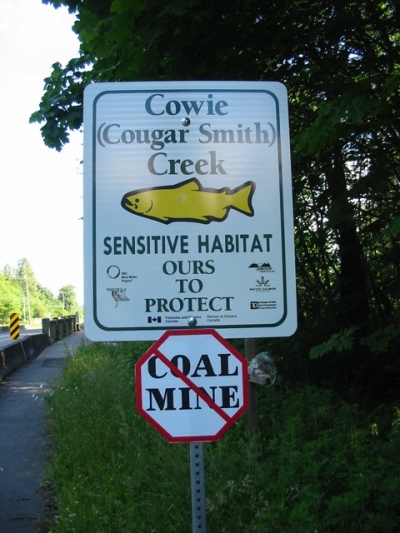
Congratulations to the people of the east coast of Vancouver Island who have been fighting the controversial Raven Coal Project, proposed by Compliance Coal Corporation. Coalwatch Comox Valley, which has played a lead role in opposing the project, has received a series of grants from our Environmental Dispute Resolution Fund (EDRF). On May 16th the BC Environmental Assessment Office (EAO) sent a letter to Compliance Coal refusing to conduct a detailed review of the project and outlining a whole host of problems with the Coal company’s application for an environmental assessment. In a letter sent to Compliance, Tracy James of the BCEAO wrote:
… [The] EAO has conducted an evaluation of the Application, taking into account the feedback received from the Working Group and First Nations. EAO has determined that the Application does not contain the required information and has decided not to accept the Application for detailed review. … Should Compliance wish to revise and resubmit its application to EAO for evaluation, we require that Compliance first incorporate into the Application the information identified in Attachment A.
 Attachment A, which is well over 100 pages long, lays out the specific requirements that Compliance failed to meet.
Attachment A, which is well over 100 pages long, lays out the specific requirements that Compliance failed to meet.
There is no doubt that the letter is a win for those opposed to the Coal mine. Coalwatch Comox Valley President, John Snyder, said in a press release:
A review of the screening comments seems to indicate significant gaps in the Application, some of it having to do with public, First Nations, and stakeholder consultation; hydrology issues; and marine baseline studies. Given the widespread concerns about our vulnerable aquifers and the Baynes Sound shellfish industry, it’s remarkable the Application contained information gaps on these important issues.
There’s no doubt that public scrutiny and the concerns voiced by local governments, First Nations, and stakeholders like the BC Shellfish Growers Association, played a role in this decision by the EAO. While Compliance could decide to resubmit another Application, this rejection by the EAO adds to an already significant headwind Compliance is facing in getting their project approved.
Again, we are proud that our funding enabled Coalwatch to have lawyer Tim Thielmann, of the law firm of Devlin Gailus, assist in Coalwatch's participation in the environmental assessment process. In our experience having lawyers actively involved in an environmental assessment processes can improve the quality of the resulting assessment.
More fundamental problems
However, as the letter makes clear, this is not a rejection of Compliance Coal’s project. It only means that the company has not spent the time answering the questions that the government, and the public, expect it to answer. And, days after the EAO’s decision, Compliance announced that it will be resubmitting its application:
The application itself was 12,000 pages long and [Compliance VP] Ellis told The NEWS on Wednesday the company wasn't shocked to receive 114 pages of questions from the EAO, information that must be included in the next submission, which Ellis said he expects will happen within the next two months.
So opponents of the coal mine will soon be deluged with hundreds or thousands more pages of technical documents evaluating the Raven Coal Project’s environmental impacts. And with the environmental assessment process only very rarely actually saying no to projects, the company may just keep re-submitting applications until it gets its approval.
Not only that, but Compliance Coal and another company have applied for new mining rights in the Comox Valley, leading one local government councilor, Gwyn Sproule, to worry about a “new gold rush”. The new Compliance Coal application is on the spectacular Forbidden Plateau, and there are concerns that the region’s drinking water could be impacted.
These new developments emphasize yet again that some areas are simply not appropriate for mine development. Everyone fears that locating the Raven Coal Project near pristine Fanny Bay, and close to residential neighbourhoods, is a disaster waiting to happen – that’s why the residents of the region are up in arms.
Similar conflicts exist around the province – with mining companies hoping to build mines in populated areas, near lands that are culturally or spiritually significant for First Nations, or in environmentally sensitive areas. It is high time to officially make such areas off-limits to mining companies.
Although coal is governed by a slightly different legal regime than other forms of mineral rights, when it comes to conflicts with other land uses the problem is the same – holders of mineral rights get a free ride from land use restrictions that apply to other industries. In BC’s “two zone” system – under which only protected areas are off-limits to mining – just about everywhere else is fair game. As our Executive Director and Senior Counsel, Jessica Clogg, wrote in the Vancouver Sun in January:
It’s time to reform the B.C. Mineral Tenure Act to identify some common sense areas that should be off-limits to new claims and leases, and end taxpayer compensation for claims affected when areas of ecological importance are protected. Comprehensive legislative reform would go a long way toward reducing land-use conflict and strife, while providing more certainty and security for the mining sector and investors.
The same could be said of BC’s Coal Act. Until BC modernizes its mining laws to balance mineral rights with other rights and values it looks like the residents of the east coast of Vancouver Island are going to have to say “no” to coal mining companies over and over.
By Andrew Gage, Staff Lawyer
Photo courtesy of Coalwatch Comox Valley.